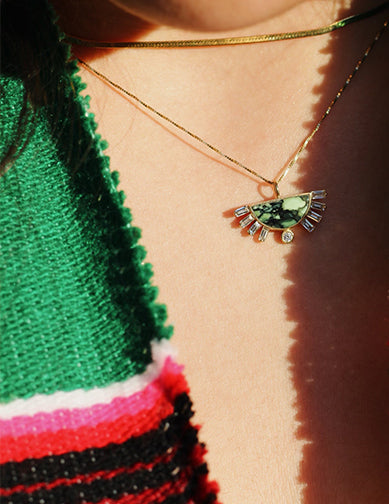Lust For Gold: Impacts Of Mining On Hispanic Culture
The quest for gold was one of the driving factors in the exploration and colonization during the earliest years of European expansion onto the American continents. With history in mind, it’s imperative that we acknowledge the loss and pain that has occurred in the pursuit of gold.

By Sofia Garcia, YITM Community Engagement Director.
It’s imperative that we acknowledge the loss and pain that has occurred in the pursuit of gold. I work to honor my Mexican and Yaqui heritage every day, and I know that it’s especially important to celebrate it during Hispanic Heritage Month. I don’t identify as Hispanic due to the U.S. government’s role in establishing the term Hispanic as a way to classify people in a way that doesn’t recognize the complex identities within the Latino/a/x/e or Chicano/A community. I have worked with the youth of the Latino/a/x/e community, and it’s because of them that I believe in the power of witnessing representation and empowering youth to celebrate their culture. Whether at school or with their family, it's important that people of all ages know that their culture is something to be proud of. I've had the privilege of working with youth in an artistic setting where we had the opportunity to talk about why older generations have fought so hard to see representation in the classroom, boardroom, media, and beyond.
The month is dedicated to celebrating the histories, cultures, and contributions of American citizens whose ancestors came from Spain, Mexico, the Caribbean, and Central and South America. It’s important to recognize that the day of September 15 is historically significant as it marks the anniversary of independence for the Latin American countries of Costa Rica, El Salvador, Guatemala, Honduras, and Nicaragua. In addition, Mexico and Chile celebrate their independence on September 16th and September 18th.
With history in mind, it’s imperative that we acknowledge the loss and pain that has occurred in the pursuit of gold.
The quest for gold was one of the driving factors in the exploration and colonization during the earliest years of European expansion onto the American continents. Gold was used by most cultures in the Americas, from Mexico south to Argentina. Using tools made of wood, bone, and leather, gold, silver, and copper have historically been manipulated using stone hammers, stone anvils, and chisels. In many cultures, but most notably in Brazilian and other South American cultures, we saw the use of gold nuggets gathered from streams to adorn the body. Peruvian and Colombian cultures shaped the trajectory of the future of jewelry with Peruvians making sheet and wire, with other uses of gold for bigger ceremonial pieces and lost-wax cast designs of the goldsmiths in Colombia. There is so much history tied to the intricate work and sacrifices made in the name of jewelry that I’m continuing to learn and attempting to understand.
These desires fueled by the admiration of gold would continue to cause pain throughout time, as seen with the failure to uphold the provision of land grants in the Treaty of Guadalupe Hidalgo, which came at the end of the Mexican-American War, which began in 1846. After two years of battle and the takeover of Mexico City, the war-ending Treaty of Guadalupe Hidalgo was signed in 1848. The treaty led to the displacement of thousands of Mexicans and Native Americans which was fueled by the economic incentive of the gold. The connection can be exemplified when you look at the territory of California. Prior to gold being discovered in California in 1848, right after the treaty was signed, there weren’t enough white, English-speaking American residents to apply for statehood. The gold rush prompted gold seekers to push out Mexican and Native American landowners if their land had any mineral value. This led to the Native population of California dropping from 150,000 to 30,000 between the years of 1848 and 1860. This painful part of history shapes my own cultural identity and is something I wish was talked about more in the classroom setting.
Conversations about the cultural impact of things like the signing of the Treaty of Guadalupe Hidalgo and other practices related to jewelry are something that can be talked about in tandem with one another in order to gain a deeper understanding of the world we live in today.
I’m constantly inspired by the conversations being led by the youth in my community and want to end this reflection with their words.
I’m highlighting the words of the 2023 Youth Fellows of the Colorado Organization for Latina Opportunity and Reproductive Rights.
Sincerely,
Sofia
Quotes from the 2023 Youth Fellows of the Colorado Organization for Latina Opportunity and Reproductive Rights (COLOR)
“As I do any work that I do, I always have my community in mind. My love for my roots and everything my parents have given up for their children to have a successful future motivated me every single day. As much as they have inspired me, I hope to do the same back from my community.”
-Ana Cerna Sanchez, Communications Fellow
“Celebrating Hispanic Heritage Month is not only about honoring the past; It’s also about empowering our future. Remembering my roots, culture, and traditions around me. My parents’ migration to the U.S. empowered the future of them, me, and our future generations.”
-Andrea Arreola Soria, Organization Fellow
“Latin America is filled with diversity and rich culture. My love for my roots has mobilized me to advocate for the well-being of our community. I hope to include the history of Latin America as well as our values into the political system to have accurate representation.”
-Erika Leon, Policy Fellow



